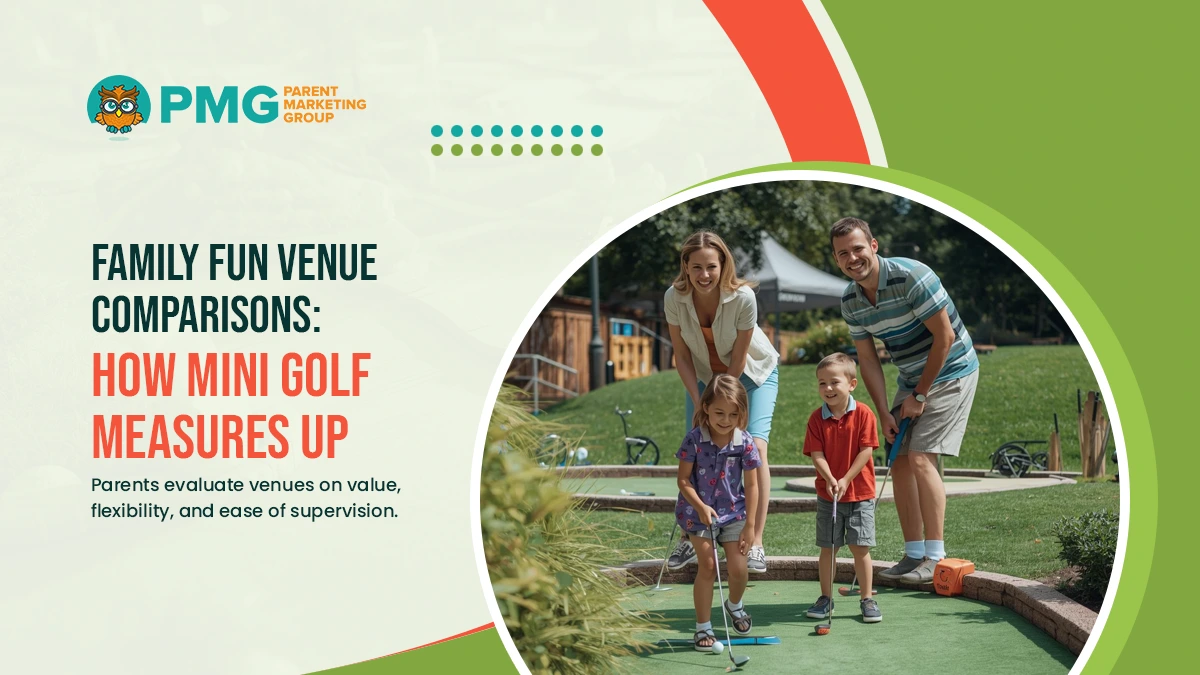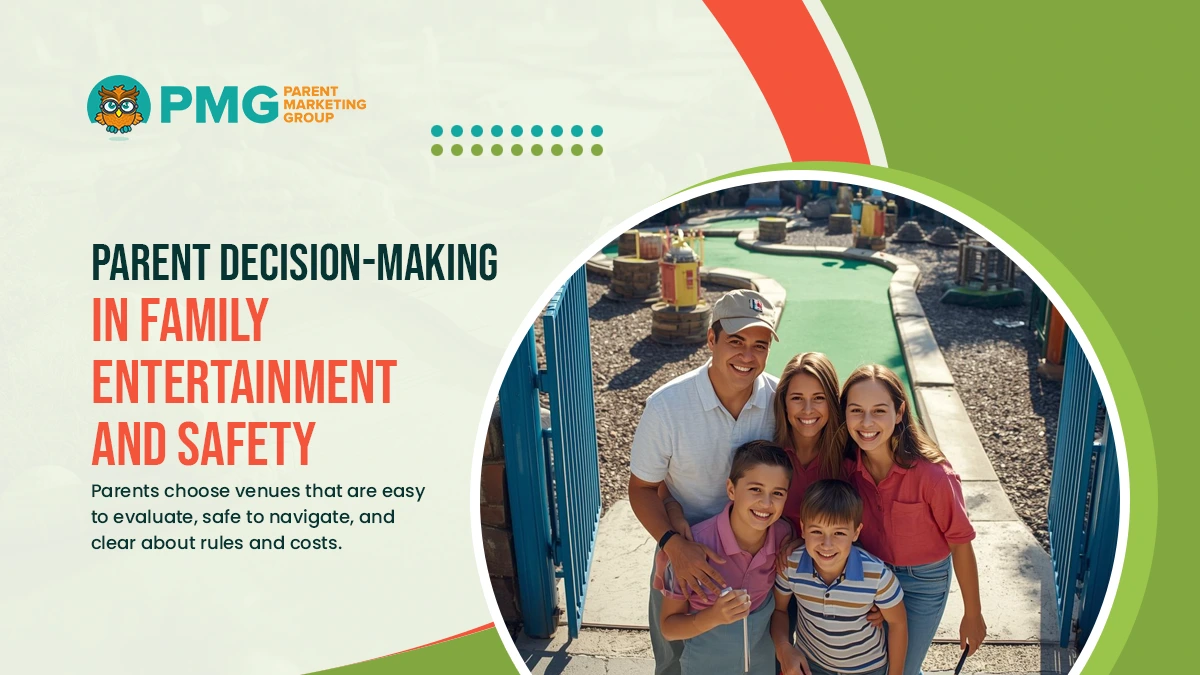 Parents prefer mini golf for family outings because it balances fun, affordability, and ease of planning. Courses offer clear pricing, short activity duration, and simple rules, which help parents schedule around naps, meals, and school commitments. The game format supports mixed ages and abilities, allowing younger children to participate while older siblings stay engaged.
Parents prefer mini golf for family outings because it balances fun, affordability, and ease of planning. Courses offer clear pricing, short activity duration, and simple rules, which help parents schedule around naps, meals, and school commitments. The game format supports mixed ages and abilities, allowing younger children to participate while older siblings stay engaged.
Safety is visible through supervised play areas, defined pathways, and equipment designed for families. Many venues provide online booking, reservable time slots, and flexible headcounts, which reduces uncertainty. Convenient parking, snack options, stroller access, and weather-friendly formats such as indoor or glow golf create a dependable experience that families can repeat throughout the year.
Family Fun Venue Comparisons: How Mini Golf Measures Up

Parents evaluate venues on value, flexibility, and ease of supervision. Mini golf performs well because it is suitable for mixed ages, keeps costs predictable, and provides a simple path from arrival to completion.
Value and Time Commitment
Mini golf offers clear per-guest pricing and short activity duration, which helps families plan around meals and naps. A typical round lasts 45 to 75 minutes, so parents can schedule without dedicating a whole afternoon. Unlike attractions requiring all-day tickets or wristbands, mini golf concentrates fun into a defined window and reduces incidental spending.
Inclusivity, Safety, and Engagement
The courses accommodate a wide range of ages and abilities. Younger children can participate with simplified strokes while older siblings pursue score goals. Safety is visible through slow play areas, defined walkways, and staff oversight. The game structure encourages turn-taking and conversation, which helps families stay engaged together rather than splitting into separate activities.
Quick comparison checklist:
- Mixed ages play the same course
- Low equipment risk and simple rules
- Easy supervision from one or two adults
- Noise levels are manageable for sensitive children
Convenience, Weather Options, and Booking
Mini golf venues are often close to neighborhoods and shopping areas, which shortens drive times and simplifies parking. Many centers offer indoor, outdoor, or glow formats that adapt to weather and season. The booking process is uncomplicated with online reservations, visible time slots, and flexible headcounts for late changes. Snack bars, stroller access, and nearby restrooms reduce friction during the visit.
When Mini Golf Wins Against Alternatives
Bowling and trampoline parks can be excellent choices, yet they may involve specialized footwear, waivers, or higher per-hour costs. Arcades provide variety but can scatter a group, making spending harder to predict.
Movies remove the need for coordination but do not provide interaction or movement. Mini golf balances activity, conversation, and predictable costs to support frequent repeat visits.
Outcome for Parents
The result is a reliable outing that fits budgets and schedules. Clear pricing, inclusive play, and simple logistics help parents feel confident. These factors explain why mini golf often wins when families compare options for weekend plans, birthdays, and visiting relatives.
Choosing Mini Golf for Kids Activities and Mixed Ages

Mini golf is suitable for various ages without complex rules or specialized gear. Parents can guide younger children while older siblings stay engaged with light competition and personal score goals.
Developmental Fit by Age Group
Preschoolers practice grip, aim, and turn-taking with simplified strokes. Early-grade children build coordination and basic skills. Tweens and teens focus on course strategy, pace control, and accuracy. The game scales naturally with ability, so the whole family participates on the same course.
Safety and Accessibility
Risk is low compared with faster or contact-based activities. Courses feature slow play areas, clear walkways, and visible staff. Kid-sized putters and lightweight balls support safe use. Many venues provide ramps for strollers and wheelchairs, handrails at stairs, and seating near greens for quick rests.
Social Skills and Family Interaction
Play proceeds in turns, encouraging patience, cheering, and shared problem-solving. Parents can model sportsmanship and help younger children set simple goals. Group scoring keeps everyone connected rather than splitting into separate activities.
Simple interaction ideas:
- Set a family par and celebrate when a hole meets it
- Rotate the first player each hole to practice fairness
- Let the birthday child choose one “fun rule” hole
Sensory Comfort and Energy Levels
The outdoors offers fresh air and room to move. Indoors or glow formats create weatherproof options with controlled environments for sensitive children. The pace allows short breaks between holes, which helps with fatigue management and attention.
Practical Planning for Parents
A typical round lasts 45 to 75 minutes, which fits before dinner or after school. Pricing is predictable with per-guest rates and clear add-ons such as extra rounds or photo keepsakes. Many courses support online reservations, visible time slots, and flexible headcounts. Common parent questions should be easy to find, including age guidelines, supervision needs, and food policies.
Outcome for Mixed Ages
Families finish together, with each child challenged at a suitable level. The activity supports movement, conversation, and simple achievements that feel rewarding. These qualities make mini golf a dependable choice for siblings and friends across multiple age groups.
Parent Decision-Making in Family Entertainment and Safety

Parents choose venues that are easy to evaluate, safe to navigate, and clear about rules and costs. Decisions center on visible safety, predictable pricing, and an experience that works for mixed ages.
Risk Assessment and Supervision
Families look for activities with low injury risk and simple oversight. Visible staff, defined pathways, and posted rules increase confidence. Lines of sight that allow one or two adults to supervise the whole group are preferred. Equipment sized for children and pacing that avoids crowding support safe participation.
Clarity of Policies and Expectations
Clear information reduces anxiety before arrival. Parents want to see age and height guidelines, waiver requirements, footwear rules, and refund or reschedule terms. Policies should be written in basic language and repeated on confirmation emails, landing pages, and on-site signage. Consistent wording across channels prevents confusion at check-in.
Budget and Time Planning
Predictable costs help families plan. Per guest pricing, package summaries, and transparent add-ons reduce surprises. A typical visit, lasting one to two hours, works well for nap schedules, meals, and other commitments. Calendar visibility and deposit options make it easier to reserve during busy periods.
Health, Cleanliness, and Accessibility
Clean facilities and routine sanitizing communicate care. Parents notice restroom availability, handwashing stations, and trash control. Accessibility matters for strollers, wheelchairs, and grandparents. Ramps, handrails, seating areas, and nearby parking improve comfort and widen participation.
Social Proof and Staff Interaction
Reviews that mention staff names, helpful hosts, and efficient check-in carry weight. Photos showing orderly play and safety briefings add credibility. Friendly, proactive staff who explain rules and answer questions reduce first-visit stress and increase the chance of return visits.
Decision Checklist for Parents
A simple checklist supports faster choices:
- Safety signals are visible, and rules are easy to follow
- Age and height guidelines match the group
- Pricing, deposits, and add-ons are clear
- The visit fits within the planned time
- Parking, bathrooms, and seating are convenient
- Reviews mention cleanliness and helpful staff
Outcome for Families
When safety, clarity, and convenience align, parents feel confident. A smooth visit balances movement, conversation, and shared achievements, strengthening the likelihood of repeat outings and referrals.
Convenience Factors: Location, Parking, and On-Site Amenities
Parents favor venues that are easy to reach, simple to navigate, and comfortable for short or extended visits. Clear access, practical amenities, and fast check-in reduce friction and improve satisfaction.
Proximity and Access
Select locations near residential areas, schools, and shopping corridors to shorten travel time. Display a precise address, recognizable cross streets, and public transit notes. Include a map with a marked entry point and a photo of the exterior so arrivals are confident they are in the right place.
Parking Design and Flow
Provide a visible entrance, directional signs, and safe pedestrian paths from the parking to the door. Reserve a few short-term spaces for party hosts and caregivers with infants. If overflow parking exists, show it on the map and repeat details in confirmation emails.
Parking essentials to highlight:
- Number of spaces and accessible spots
- Drop-off zone location
- Evening lighting and security presence
On-Site Amenities That Matter
Offer restrooms near activity areas and a family restroom with a changing space. Keep drinking water available and place seating where caregivers can supervise comfortably. If a snack bar exists, publish a concise menu with pricing and note allergy-friendly options. Provide lockers or cubbies for bags and jackets.
Wayfinding and Check-In
Use clear interior signage for party rooms, waivers, and safety briefings. Place a staffed welcome desk near the entrance and display current wait times. Enable digital check-in with a QR code and support mobile waivers to shorten lines during peak hours.
Family Services and Accessibility
Support strollers and wheelchairs with ramps, wide aisles, and handrails where needed. Maintain a small, quiet area for children who need a sensory break. Keep basic first aid supplies on hand and train staff to respond calmly to everyday situations.
Information Availability and Booking Links
Publish hours, special schedules, and any temporary closures. List age and height guidelines, supervision rules, and food policies on a single page. Provide a visible Book Now button and a Manage Booking link inside confirmation emails so headcounts and time slots can easily be adjusted.
Conclusion
Parents choose mini golf because it delivers predictable value, inclusive play, and simple logistics. Clear pricing and short activity duration fit family schedules. Mixed-age participants participate together without special gear. Safety is visible, and supervision is straightforward. Convenient locations, reliable parking, and practical amenities remove friction from arrival to checkout. When these elements come together, families feel confident planning repeat visits and celebrations, and venues earn consistent revenue from everyday outings and birthday events.
Ready to translate these parent preferences into higher bookings for your course. Call (716) 303-4133 or contact the team at https://parentmarketing.com/contact-us.





